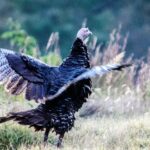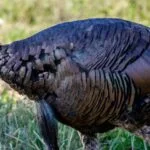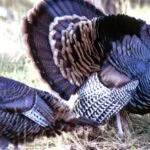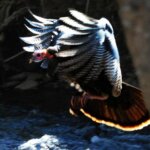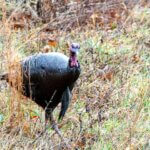Editor’s Note: Wild turkeys have their own vocabulary. Although scientists and hunters attempt to explain the vocabulary of the wild turkey, their statements and conclusions may be contradictory. Not until someone teaches a turkey to speak English will we find out exactly what each sound means. But here’s an explanation of the sounds turkeys make and how and when to use them.
“When I turkey hunt, I cluck three times and then throw my turkey call away,” one old timer told me. “I’m convinced that the reason more hunters don’t take more turkeys is that they call too much. If you hear a turkey gobble, cluck three times. He will gobble back. That old tom will know your position. Sooner or later he’ll come to you. If you keep making calls, you’ll mess-up. Patience will kill more gobblers than calling.” That advice was given to me many years ago, and I’ve often thought about the wisdom contained in the old man’s words when I’ve caught myself overcalling.
 * Cluck: A simple cluck is as effective as any call that can be made. It’s also one of the easiest calls to make. On a mouth diaphragm, meter a small burst of air over your tongue and past the diaphragm. On a box call, simply make one short, quick note. You even can rest your thumbs on the top of the box and tap the lid to make a cluck. When using the slate call, give a short strike across the slate to create a single note. On the push button call, gently tap the dowel to produce a cluck. The cluck is especially effective when a gobbler is in close range, and you don’t need to do much calling.
* Cluck: A simple cluck is as effective as any call that can be made. It’s also one of the easiest calls to make. On a mouth diaphragm, meter a small burst of air over your tongue and past the diaphragm. On a box call, simply make one short, quick note. You even can rest your thumbs on the top of the box and tap the lid to make a cluck. When using the slate call, give a short strike across the slate to create a single note. On the push button call, gently tap the dowel to produce a cluck. The cluck is especially effective when a gobbler is in close range, and you don’t need to do much calling.
* Yelp: The yelp is the call that hunters use most of the time. Follow a cluck with some light yelping, because a cluck may be misinterpreted by a gobbler as an alarm putt. If a cluck is followed by a series of yelps, there’s no way a tom can misinterpret the call for a putt.
The faster the yelps are given, the more excited the hen appears to be. The louder the yelps, generally, the more pleading the call is. You can put many levels of emotion into a series of yelps. To produce a yelp on a mouth diaphragm, meter the air in short bursts over the tongue and between the tongue and diaphragm. With a slate or a plexiglass friction call, move the peg in a circle. The faster you move the peg, the more excited the yelps sound. With the box call, move the paddle across the edge of the box in a regular cadence. With the push button call, push the dial on the call back and forth with a regular rhythm to imitate the yelp. The yelp is often given when you want to call the bird in without getting him too excited.
* Cackle: The cackle is a series of fast yelps and denotes excitement in the hen. If a gobbler is slow to come in, use the cackle to speed-up the bird’s progress and excite him with the prospect of mating. To produce the cackle with the mouth diaphragm, blow quickly, using the tongue to pick-out each note of the cackle on the rubber membrane of the call. On the box call, quickly move the lid of the box over the side of the call in rapid succession. On the slate call, make the same circles as when giving the yelp, but make them quicker, putting excitement into the cackle. With a push button call, quickly push or pull the dowel to imitate the cackle.
* Assembly Call: This call is primarily given in the fall and consists of a series of loud yelps with a lot of pleading. The same technique described when talking about the yelp call applies to the assembly yelp, except that you should start the call off quietly. Then build each yelp louder and louder. The assembly call is the vocalization that the hen uses when she’s gathering her flock.
 * Purr: This very-subtle, contented call often is used by a hen when she’s feeding and is especially effective for a hunter to use when a gobbler hangs-up just out of gun range. This call tells the gobbler that although he’s close by and strutting his stuff, the hen can care less. Oftentimes, this call will hurt an ole bird’s pride so badly that he will come waltzing right in to where you’re waiting.
* Purr: This very-subtle, contented call often is used by a hen when she’s feeding and is especially effective for a hunter to use when a gobbler hangs-up just out of gun range. This call tells the gobbler that although he’s close by and strutting his stuff, the hen can care less. Oftentimes, this call will hurt an ole bird’s pride so badly that he will come waltzing right in to where you’re waiting.
The purr is produced very softly on a diaphragm call with only the smallest bit of air forced between the tongue and the diaphragm. On the slate call, drag the peg across the slate with the slightest pressure. On a box call, move the lid lightly across the side of the box.
* Putt: The only time you should use the putt is when a gobbler comes strutting-in, and you want to break him out of the strut. The putt is a sharp, loud cluck. This call will successfully break a tom out of his strut. Usually a tom will stick his head straight-up when he hears that call. You then have only a second to shoot. The only difference between the cluck and the putt is the severity and the crispness of the sound. The cluck is a soft sound; the putt is a very-hard sound. Rarely should you use this call.
 * Tree Call: To make a tree call, use the same action described to give a yelp, but reduce the amount of air being forced through the diaphragm call. This produces a lighter yelp. With friction calls, use less force on the lid of the box. With a slate call, use less force on the striker. On the push button call, pull the dowel much easier and slower. The tree call is given first thing in the morning before first light when the turkeys are beginning to wake-up. The tree call lets the gobbler know the hens’ location – if he’s in the mood when he flies-down.
* Tree Call: To make a tree call, use the same action described to give a yelp, but reduce the amount of air being forced through the diaphragm call. This produces a lighter yelp. With friction calls, use less force on the lid of the box. With a slate call, use less force on the striker. On the push button call, pull the dowel much easier and slower. The tree call is given first thing in the morning before first light when the turkeys are beginning to wake-up. The tree call lets the gobbler know the hens’ location – if he’s in the mood when he flies-down.
To learn more about turkey hunting, check out John E. Phillips’ print, Audible, Kindle and Nook turkey books at https://johninthewild.com/books/#turkey and at www.barnesandnoble.com. You also can download a free Kindle app that enables you to read the book on your iPad, computer or SmartPhone. You can learn more about calling turkeys by going to johninthewild.com/audio-files/ for audio turkey tapes to purchase of Lovett Williams, Rob Keck and Chris Kirby, available for download to your SmartPhone, tablet or computer. For a free copy of John E. Phillips’ “The Turkey Gobbler Getter Manual,” go to https://johninthewild.com/free-books/ to download.




